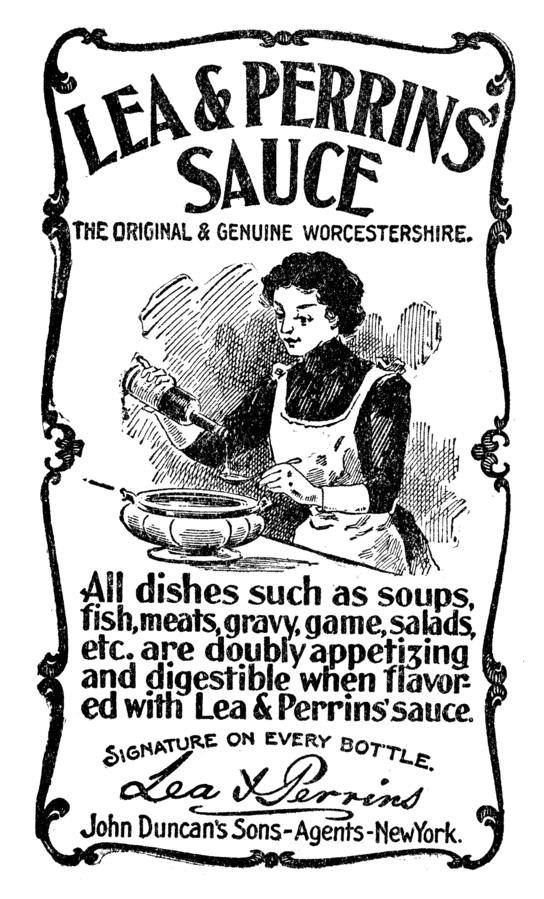The Story of Worcestershire Sauce: Origins, Uses, and Bonus Facts
I've spent half a century (yikes) writing for radio and print—mostly print. I hope to be still tapping the keys as I take my last breath.
Those who like a little tangy dash of savoury goodness in their poultry, fish, meat, or eggs have to thank two British chemists (pharmacists in North American parlance), John Lea and William Perrins. The two men were fiddling about with ingredients in the 1830s when they seem to have stumbled onto what has come to be known as Worcestershire sauce.
The Origin of Worcestershire Sauce
Lea & Perrins®, the company that launched the sauce in 1835, says it originated from a request from Lord Marcus Sandys. Freshly returned from his arduous duties as Governor of Bengal, his lordship was settling into the family seat of Ombersley Court, Worcestershire. During his travels in India he acquired a recipe for a sauce he found most toothsome and he gave this to Lea and Perrins and asked them to replicate it.
The two chemists messed about with a tincture of this, a soupçon of that, and a dash of something else. The company says the chemists “were not impressed with their initial results.” The word “Blech” may well have been uttered and a barrel of the mixture was consigned to the basement.
Lea & Perrins picks up the story: “A few years later, they stumbled across [the mixture] and decided to taste the contents again. To their delight, the aging process had turned it into a delicious, savoury sauce.”
Some cast doubt on this official history by referring to it “as the story goes” or “according to company tradition.” Even more suspicious is the fact that the British Museum’s short biography of Lord Marcus Sandys makes no mention of his ever having been in India.
But, it’s a nice yarn so let’s go with it.
The Ingredients of Worcestershire Sauce
Of course, the exact recipe for the condiment is a secret known only to a privileged few. However, modern labelling rules require that the ingredients be listed. Here’s what the company says is in their brew: “Aromatic with garlic, tangy with distilled white vinegar & tamarind extract, spicy with chilli pepper extract and sweet with sugar and molasses.”
Others have reverse engineered the product and have detected everybody’s favourite pizza topping, anchovies, along with mysterious “natural flavours” and unspecified “spices.”
The flavour is what’s known as umami; this is a Japanese word that means “a pleasant savoury taste.” In The New Yorker, Heather Goldfield describes umami as “That deep, dark, meaty intensity that distinguishes seared beef, soy sauce, ripe tomato, Parmesan cheese, anchovies, and mushrooms, among other things. It hits the back of your throat and leaves you craving more.”
The public took to the sauce quickly as it gussied up the flavour of otherwise rather bland British food. Lea & Perrins had a hit on their hands so, in the best tradition of capitalism, other companies copied the original, with mixed success, in order to scoop up some of the loot.
There’s a “food media” outfit in the Philippines that taste-tested several brands of Worcestershire Sauce and went completely wine-snobbish in its descriptions.
The American Garden product is described as having a “sweet, tangy front and complex profile of spices that epitomize Worcestershire sauce—just conveyed in a more assertive light.”
Or, here’s the French’s version, “we detect allspice or clove, and the slightly grassy echo of celery seed [that] . . . flaunts a tanginess that isn’t as specifically vinegar-y but is clear and bright nonetheless, evened out with a mid-level sweetness.”
C’mon guys, get a grip; this is a condiment you’re talking about not Château Lafite Rothschild.
Uses of Worcestershire Sauce
The original manufacturer has several pages of recipe ideas. You can go full-on gourmet with Creamy Mussels Montpellier, or improve a simple comfort food by adding a couple of teaspoons of Worcestershire Sauce to a grilled cheese sandwich.
Mostly, the sauce is used as a flavour enhancer for beef, pork, poultry, and fish; brush it on while barbecuing or use it as a marinade before cooking.
Add it to soups, stews, and salad dressings for a splash of tanginess.
Alex Delany (Bon Appétit) writes that “Whether you’re braising in red wine, dropping vegetables into chicken broth, or even making something creamy like a chowder or a pot pie, the range of flavor in Worcestershire makes it a pretty versatile ingredient.”
The Bloody Mary
However, the real reason Worcestershire Sauce was invented was so it could be put into a Bloody Mary cocktail. The creators were just ahead of their time.
Harry’s New York Bar in Paris is said to be where the Bloody Mary was invented, but there are plenty of other claimants. That was supposedly in 1921 when the cocktail was known as a Bucket of Blood.
You can’t make a Bloody Mary without Worcestershire Sauce. Well, you can, but then it wouldn’t be a Bloody Mary.
The classic, no-frills, recipe is:
- 1½ ounces vodka
- ½ cup tomato juice
- Three or four dashes Worcestershire Sauce
- Juice of half a lemon
Shake together with ice and pour into a tall glass; pretty it up with a celery stick with leaves.
Of course, folk have gone bonkers messing about with this simple but good cocktail. If you must put a few dashes of Tabasco Sauce in then okay. But a strip of bacon or some beef bouillon powder? No, just no. Other sacrilegious additions are horseradish sauce, gherkins, and shrimp.
But, every recipe, even the abominations, includes Worcestershire Sauce.
Bonus Factoids
- Authentic Worcestershire sauce contains anchovies so it’s off the menu for vegans. If used on meat, it also breaks Orthodox Jewish dietary laws which forbid eating meat and fish in the same dish.
- It’s known as the English sauce in Denmark (Engelsk sauce), in El Salvador and Venezuela (salsa inglesa), and in Brazil and Portugal (molho ingles).
- Lea & Perrins has long since disappeared as a company. It has passed through the hands of HP Foods, oddly Imperial Tobacco, Danone, and, currently, Heinz.
- It’s pronounced WOO-ster-sheer, not Wor-CESTER-shire as is sometimes heard in America. The double "O" is pronounced as in good of wood.
Failed Attempts at Worcestershire Sauce Pronunciations
Sources
- “The Classic Bloody Mary Recipe.” Mixthatdrink.com, undated.
- “About Us.” Lea & Perrins, undated.
- “We Try 6 Brands of Worcestershire Sauces; Can Any of Them Match Lea & Perrins?” Pepper.ph, undated.
- “You Think You Know Umami.” Heather Goldfield, New Yorker, March 19, 2015
- “What Is Worcestershire Sauce?” Peggy Trowbridge Filippone, thespruceeats.com, July 22, 2020.
- “What Is Worcestershire Sauce, Anyway?” Alex Delany, Bon Appétit, December 20, 2018.
© 2021 Rupert Taylor
Comments
Chitrangada Sharan from New Delhi, India on January 22, 2021:
Interesting and informative article about the Worcestershire sauce. I have used it sometimes. It adds good flavour. Good to know about it’s history.
Thank you for sharing.
Peggy Woods from Houston, Texas on January 22, 2021:
Thanks for the history lesson regarding Worcestershire Sauce. We always have a bottle of it in our refrigerator, along with soy sauce and other condiments. It adds terrific flavoring to foods.
Ann Carr from SW England on January 22, 2021:
Funny, I thought of that example too; great minds & all that!
Rupert Taylor (author) from Waterloo, Ontario, Canada on January 22, 2021:
Thanks Ann for the pronunciation guide. It makes sense to clarify that Woo is not pronounced like Bertie Wooster.
Ann Carr from SW England on January 22, 2021:
Informative and amusing article about Worcestershire Sauce (often referred to in Britain as merely Worcester sauce). I tend to use Soy Sauce instead, a slightly different flavour of course.
Being a linguist and aware of the vagaries of pronunciation, I'd like to further clarify that the 'Woo' of Worcester is 'oo' as in 'good' not as in 'food'. I know it's picky but, to me, it's important!
We have these counties where the 'ces' is confusing (Worcestershire, Leicestershire, Gloucestershire) but if you divide them phonetically into Worce/ster, then the two 's' sounds blend and make sense! What a complicated language we have! Hope you don't mind the digression, Rupert. The teacher in me will out, I'm afraid.
Hope you're keeping safe and well.
Ann
John Hansen from Queensland Australia on January 21, 2021:
Thank you for sharing the history of Worcestershire sauce, Rupert. I always have a bottle on hand to add a few splashes to so any things. It is very versatile, but I watched a video on how it is made and somehow wish I hadn’t..it is a little off-putting. The brand I usually use is Holbrooks, however.
DW Davis from Eastern NC on January 21, 2021:
Thanks for the history lesson. It is always interesting to learn the roots of things we often take for granted such as Worcestershire Sauce.
I am a fan of using Worcestershire Sauce when cooking pork and chicken. It adds flavor to otherwise bland meats.



















